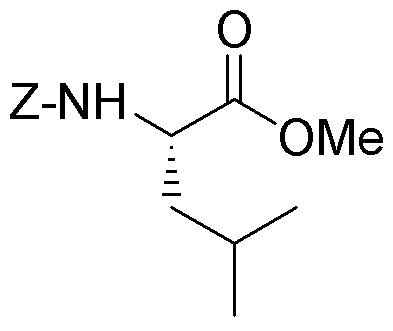Z-Leucine methyl ester is widely utilized in research focused on:
- Peptide Synthesis: This compound serves as a key building block in the synthesis of peptides, which are essential for drug development and biological research.
- Pharmaceutical Formulations: It is used in the formulation of various pharmaceuticals, enhancing the solubility and bioavailability of active ingredients, which is crucial for effective medication.
- Biochemical Studies: Researchers employ Z-Leucine methyl ester in studies related to protein structure and function, aiding in the understanding of metabolic pathways.
- Cosmetic Applications: The compound is also found in some cosmetic formulations, where it contributes to skin hydration and nourishment, appealing to the beauty industry.
- Food Industry: It is used as a flavoring agent or nutritional supplement in food products, providing benefits to manufacturers looking to enhance taste and nutritional value.
General Information
Properties
Safety and Regulations
Applications
Z-Leucine methyl ester is widely utilized in research focused on:
- Peptide Synthesis: This compound serves as a key building block in the synthesis of peptides, which are essential for drug development and biological research.
- Pharmaceutical Formulations: It is used in the formulation of various pharmaceuticals, enhancing the solubility and bioavailability of active ingredients, which is crucial for effective medication.
- Biochemical Studies: Researchers employ Z-Leucine methyl ester in studies related to protein structure and function, aiding in the understanding of metabolic pathways.
- Cosmetic Applications: The compound is also found in some cosmetic formulations, where it contributes to skin hydration and nourishment, appealing to the beauty industry.
- Food Industry: It is used as a flavoring agent or nutritional supplement in food products, providing benefits to manufacturers looking to enhance taste and nutritional value.
Documents
Safety Data Sheets (SDS)
The SDS provides comprehensive safety information on handling, storage, and disposal of the product.
Product Specification (PS)
The PS provides a comprehensive breakdown of the product’s properties, including chemical composition, physical state, purity, and storage requirements. It also details acceptable quality ranges and the product's intended applications.
Certificates of Analysis (COA)
Search for Certificates of Analysis (COA) by entering the products Lot Number. Lot and Batch Numbers can be found on a product’s label following the words ‘Lot’ or ‘Batch’.
*Catalog Number
*Lot Number
Certificates Of Origin (COO)
This COO confirms the country where the product was manufactured, and also details the materials and components used in it and whether it is derived from natural, synthetic, or other specific sources. This certificate may be required for customs, trade, and regulatory compliance.
*Catalog Number
*Lot Number
Safety Data Sheets (SDS)
The SDS provides comprehensive safety information on handling, storage, and disposal of the product.
DownloadProduct Specification (PS)
The PS provides a comprehensive breakdown of the product’s properties, including chemical composition, physical state, purity, and storage requirements. It also details acceptable quality ranges and the product's intended applications.
DownloadCertificates of Analysis (COA)
Search for Certificates of Analysis (COA) by entering the products Lot Number. Lot and Batch Numbers can be found on a product’s label following the words ‘Lot’ or ‘Batch’.
*Catalog Number
*Lot Number
Certificates Of Origin (COO)
This COO confirms the country where the product was manufactured, and also details the materials and components used in it and whether it is derived from natural, synthetic, or other specific sources. This certificate may be required for customs, trade, and regulatory compliance.


